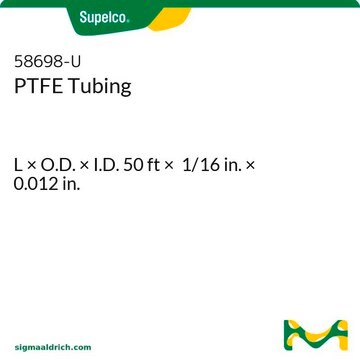Key Documents
71376
Sodium chloride
BioUltra, for molecular biology, ≥99.5% (AT)
Synonim(y):
Salt, Halite, NaCl
About This Item
Polecane produkty
klasa czystości
for molecular biology
Poziom jakości
ciśnienie pary
1.33 (1.00 mmHg) at 865 °C hPa
linia produktu
BioUltra
Próba
≥99.5% (AT)
Postać
solid
dostępność
not available in (Sales restrictions may apply)
metody
mass spectrometry (MS): suitable
western blot: suitable
zanieczyszczenia
DNases, none detected
RNases, none detected
insoluble matter, passes filter test
phosphatases, none detected
proteases, none detected
≤0.001% total nitrogen (N)
pH
5.0-8.0 (25 °C, 1 M in H2O)
mp
801 °C (lit.)
rozpuszczalność
H2O: 1 M at 20 °C, clear, colorless
gęstość
2.16 g/cm3 at 25 °C (77 °F)
ślady anionów
bromide (Br-): ≤50 mg/kg
hexacyanoferrate(II) ([Fe(CN)6]4-): ≤1 mg/kg
iodide (I-): ≤10 mg/kg
phosphate (PO43-): ≤5 mg/kg
sulfate (SO42-): ≤200 mg/kg
ślady kationów
Al: ≤5 mg/kg
As: ≤0.1 mg/kg
Ba: ≤5 mg/kg
Bi: ≤5 mg/kg
Ca: ≤10 mg/kg
Cd: ≤5 mg/kg
Co: ≤5 mg/kg
Cr: ≤5 mg/kg
Cu: ≤5 mg/kg
Fe: ≤1 mg/kg
K: ≤50 mg/kg
Li: ≤5 mg/kg
Mg: ≤5 mg/kg
Mn: ≤5 mg/kg
Mo: ≤5 mg/kg
Ni: ≤5 mg/kg
Pb: ≤5 mg/kg
Sr: ≤5 mg/kg
Zn: ≤5 mg/kg
ciąg SMILES
[Na+].[Cl-]
λ
1 M in H2O
absorpcja UV
λ: 260 nm Amax: ≤0.01
λ: 280 nm Amax: ≤0.01
przydatność
suitable for component for culture media
suitable for molecular biology
Zastosowanie
genomic analysis
InChI
1S/ClH.Na/h1H;/q;+1/p-1
Klucz InChI
FAPWRFPIFSIZLT-UHFFFAOYSA-M
Szukasz podobnych produktów? Odwiedź Przewodnik dotyczący porównywania produktów
Opis ogólny
Zastosowanie
- as a component of buffer solution to prepare the pH solutions for open-circuit potential and cyclic voltammetry
- in the preparation of Bold’s basal medium (BBM)
- as a component of transcription and annealing buffer
- to maintain osmotic balance and ensure the purity and stability of the isolated extracellular vesicles (EVs)
- as a buffer for the lamination of lateral flow strips in the fabrication of lateral flow devices
Działania biochem./fizjol.
Cechy i korzyści
- Suitable for molecular biology and biochecmial research
- Free from DNase, RNase, NICKase and protease
- Tested to confirm low levels of heavy metal contamination, ensuring suitability for various applications.
- Tested for the presence of Anionic and Cationic traces
Inne uwagi
produkt podobny
Kod klasy składowania
13 - Non Combustible Solids
Klasa zagrożenia wodnego (WGK)
WGK 1
Temperatura zapłonu (°F)
Not applicable
Temperatura zapłonu (°C)
Not applicable
Środki ochrony indywidualnej
Eyeshields, Gloves, type N95 (US)
Certyfikaty analizy (CoA)
Poszukaj Certyfikaty analizy (CoA), wpisując numer partii/serii produktów. Numery serii i partii można znaleźć na etykiecie produktu po słowach „seria” lub „partia”.
Masz już ten produkt?
Dokumenty związane z niedawno zakupionymi produktami zostały zamieszczone w Bibliotece dokumentów.
Klienci oglądali również te produkty
Nasz zespół naukowców ma doświadczenie we wszystkich obszarach badań, w tym w naukach przyrodniczych, materiałoznawstwie, syntezie chemicznej, chromatografii, analityce i wielu innych dziedzinach.
Skontaktuj się z zespołem ds. pomocy technicznej



